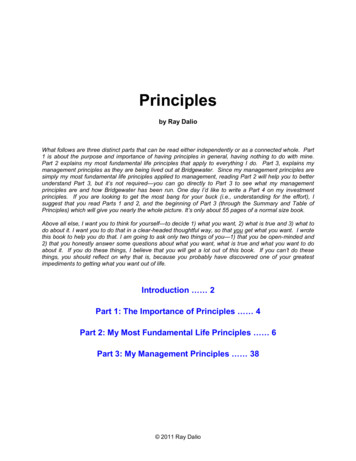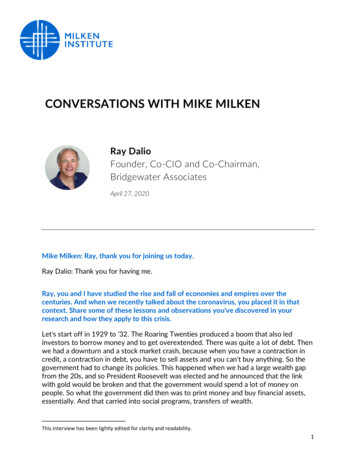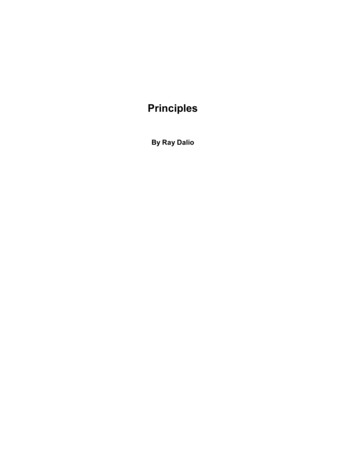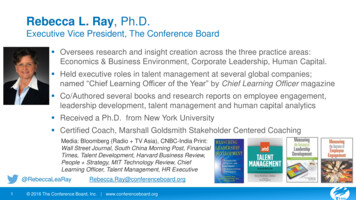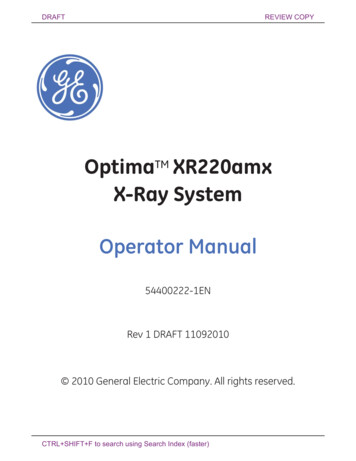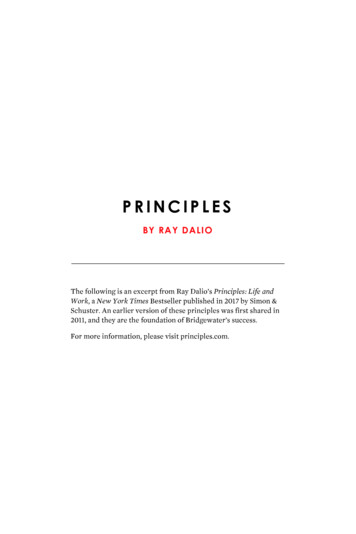
Transcription
PRINCIPLESBY RAY DALIO
SUM M ARY AN D TAB LEO F LI F E PR I N CI PLE S Thinkfor yourself to decide 1) what you want,2) what is true, and 3) what you should do toachieve #1 in light of #2, and do that with humilityand open-mindedness so that you consider thebest thinking available to you.LIFE PRINCIPLES INTRODUCTION Lookto the patterns of those things that affect youin order to understand the cause-effect relationshipsthat drive them and to learn principles for dealingwith them effectively.PART II : LIFE PRINCIPLES1.1 Be a hyperrealist.a.Dreams Reality Determination A Successful Life.1.2 Truth—or, more precisely, an accurate understanding of reality—is the essential foundation for any good outcome.1.3 Be radically open-minded and radically transparent.a.b.c. Radical open-mindedness and radical transparency areinvaluable for rapid learning and effective change.Don’t let fears of what others think of you stand in your way.Embracing radical truth and radical transparency will bringmore meaningful work and more meaningful relationships.1.4 Look to nature to learn how reality works.Don’t get hung up on your views of how things “should” bebecause you will miss out on learning how they really are.b. To be “good,” something must operate consistently with thelaws of reality and contribute to the evolution of the whole; thatis what is most rewarded.c. Evolution is the single greatest force in the universe; it is theonly thing that is permanent and it drives everything.d. Evolve or die.a.
LIFE PRINCIPLES1.5 Evolving is life’s greatest accomplishment and its greatestreward.The individual’s incentives must be aligned with the group’sgoals.b. Reality is optimizing for the whole—not for you.c. Adaptation through rapid trial and error is invaluable.d. Realize that you are simultaneously everything and nothing—and decide what you want to be.e. What you will be will depend on the perspective you have.a.1.6 Understand nature’s practical lessons. Maximize your evolution. Remember “no pain, no gain.”c. It is a fundamental law of nature that in order to gainstrength one has to push one’s limits, which is painful.a.b.1.7 Pain Reflection Progress.a.b. Go to the pain rather than avoid it. Embrace tough love.1.8 Weigh second- and third-order consequences.1.9 Own your outcomes.1.10 Look at the machine from the higher level. Th ink of yourself as a machine operating within a machineand know that you have the ability to alter your machines toproduce better outcomes.b. By comparing your outcomes with your goals, you candetermine how to modify your machine.c. Distinguish between you as the designer of your machineand you as a worker with your machine.d. The biggest mistake most people make is to not seethemselves and others objectively, which leads them tobump into their own and others’ weaknesses again and again.e. Successful people are those who can go above themselves tosee things objectively and manage those things to shape change.f. Asking others who are strong in areas where you are weakto help you is a great skill that you should develop no matterwhat, as it will help you develop guardrails that willprevent you from doing what you shouldn’t be doing.g. Because it is difficult to see oneself objectively, you need torely on the input of others and the whole body of evidence.h. If you are open-minded enough and determined, you canget virtually anything you want.a.
PRINCIPLES2 Use the 5-Step Process to Get What You WantOut of Life2.1 Have clear goals.a.b.c.d.e.f.g.h.Prioritize: While you can have virtually anything you want,you can’t have everything you want. Don’t confuse goals with desires.Decide what you really want in life by reconciling yourgoals and your desires. Don’t mistake the trappings of success for success itself.Never rule out a goal because you think it’s unattainable.Remember that great expectations create great capabilities. Almost nothing can stop you from succeeding if you havea) flexibility and b) self-accountability.Knowing how to deal well with your setbacks is as importantas knowing how to move forward.2.2 Identify and don’t tolerate problems.a.b.c.d.e.f. View painful problems as potential improvements that arescreaming at you.Don’t avoid confronting problems because they are rooted inharsh realities that are unpleasant to look at.Be specific in identifying your problems. Don’t mistake a cause of a problem with the real problem.Distinguish big problems from small ones.Once you identify a problem, don’t tolerate it.2.3 Diagnose problems to get at their root causes.a.b.c.Focus on the “what is” before deciding “what to do about it.” Distinguish proximate causes from root causes.Recognize that knowing what someone (including you) islike will tell you what you can expect from them.2.4 Design a plan.a.b.c.d.e.f. Go back before you go forward. Think about your problem as a set of outcomes producedby a machine.Remember that there are typically many paths to achievingyour goals. Think of your plan as being like a movie script in that youvisualize who will do what through time.Write down your plan for everyone to see and to measureyour progress against.Recognize that it doesn’t take a lot of time to design agood plan.2.5 Push through to completion.a.b.c. Great planners who don’t execute their plans go nowhere. Good work habits are vastly underrated.Establish clear metrics to make certain that you arefollowing your plan.
LIFE PRINCIPLES2.6 Remember that weaknesses don’t matter if you find solutions.a.b.Look at the patterns of your mistakes and identify at whichstep in the 5-Step Process you typically fail. Everyone has at least one big thing that stands in the wayof their success; find yours and deal with it.2.7 Understand your own and others’ mental maps and humility.3 Be Radically Open-Minded3.1 Recognize your two barriers.a. Understandyour ego barrier.two “yous” fight to control you.c. Understand your blind spot barrier.b. Your3.2 Practice radical open-mindedness.a.b.c.d.e.f.g.Sincerely believe that you might not know the best possiblepath and recognize that your ability to deal well with “notknowing” is more important than whatever it is you do know. Recognize that decision making is a two-step process:First take in all the relevant information, then decide.Don’t worry about looking good; worry about achievingyour goal. Realize that you can’t put out without taking in. Recognizethat to gain the perspective that comes fromseeing things through another’s eyes, you must suspendjudgment for a time—only by empathizing can you properlyevaluate another point of view. Remember that you’re looking for the best answer, notsimply the best answer that you can come up with yourself.Be clear on whether you are arguing or seeking to understand,and think about which is most appropriate based on your andothers’ believability.3.3 Appreciate the art of thoughtful disagreement.3.4 Triangulate your view with believable people who are willingto disagree.a. Planfor the worst-case scenario to make it as good aspossible.3.5 Recognize the signs of closed-mindedness andopen-mindedness that you should watch out for.3.6 Understand how you can become radically open-minded.a. Regularlyuse pain as your guide toward quality reflection.being open-minded a habit. Getto know your blind spots. If a number of different believable people say you are doingsomething wrong and you are the only one who doesn’t seeit that way, assume that you are probably biased.Meditate. Be evidence-based and encourage others to be the same.b. Makec.d.e.f.
PRINCIPLESg. Doh.i.everything in your power to help others also beopen-minded.Use evidence-based decision-making tools. Know when it’s best to stop fighting and have faith in yourdecision-making process.4 Understand That People Are Wired Very Differently4.1 Understand the power that comes from knowing how youand others are wired.a. We are born with attributes that can both help us and hurtus, depending on their application.4.2 Meaningful work and meaningful relationships aren’t justnice things we chose for ourselves—they are geneticallyprogrammed into us.4.3 Understand the great brain battles and how to control themto get what “you” want. Realize that the conscious mind is in a battle with thesubconscious mind.b. Know that the most constant struggle is between feelingand thinking.c. Reconcile your feelings and your thinking.d. Choose your habits well.e. Train your “lower-level you” with kindness and persistenceto build the right habits.f. Understand the differences between right-brained andleft-brained thinking.g. Understand how much the brain can and cannot change.a.4.4 Find out what you and others are like. Introversion vs. extroversion. Intuiting vs. sensing.c. Thinking vs. feeling.d. Planning vs. perceiving.e. Creators vs. refiners vs. advancers vs. executors vs. flexors.f. Focusing on tasks vs. focusing on goals.g. Workplace Personality Inventory.h. Shapers are people who can go from visualization toactualization.a.b.4.5 Getting the right people in the right roles in support of yourgoal is the key to succeeding at whatever you choose toaccomplish.a.Manage yourself and orchestrate others to get what you want.5 Learn How to Make Decisions Effectively5.1 Recognize that 1) the biggest threat to good decision makingis harmful emotions, and 2) decision making is a two-stepprocess (first learning and then deciding).
LIFE PRINCIPLES5.2 Synthesize the situation at hand. One of the most important decisions you can make iswho you ask questions of.b. Don’t believe everything you hear.c. Everything looks bigger up close.d. New is overvalued relative to great.e. Don’t oversqueeze dots.a.5.3 Synthesize the situation through time.a. Keepb.c.d.in mind both the rates of change and the levels ofthings, and the relationships between them. Be imprecise. Rememberthe 80/20 Rule and know what the key20 percent is. Be an imperfectionist.5.4 Navigate levels effectively.a. Use b.the terms “above the line” and “below the line” toestablish which level a conversation is on. Remember that decisions need to be made at theappropriate level, but they should also be consistentacross levels.5.5 Logic, reason, and common sense are your best tools forsynthesizing reality and understanding what to do about it.5.6 Make your decisions as expected value calculations.a. Raisingb.c.the probability of being right is valuable no matterwhat your probability of being right already is. Knowing when not to bet is as important as knowing whatbets are probably worth making.The best choices are the ones that have more pros than cons,not those that don’t have any cons at all.5.7 Prioritize by weighing the value of additional informationagainst the cost of not deciding.a. Allb.c.of your “must-dos” must be above the bar before youdo your “like-to-dos.” Chances are you won’t have time to deal with theunimportant things, which is better than not havingtime to deal with the important things.Don’t mistake possibilities for probabilities.5.8 Simplify!5.9 Use principles.5.10 Believability weight your decision making.5.11 Convert your principles into algorithms and have thecomputer make decisions alongside you.5.12 Be cautious about trusting AI without havingdeep understanding.
SUM M ARY AN D TAB LEO F WORK PR I N CI PLE SI’m including this summary and table of Work Principles here so that youhave the choice of skimming them all, finding the ones you’re most interestedin, or skipping this section and continuing your reading on page 296.PART III : WORK PRINCIPLES organization is a machine consisting of twoAnmajor parts: culture and people.a. Ab.c. great organization has both great people and a greatculture. Great people have both great character and greatcapabilities.Great cultures bring problems and disagreements to thesurface and solve them well, and they love imagining andbuilding great things that haven’t been built before. Toughlove is effective for achieving both greatwork and great relationships.a. Inorder to be great, one can’t compromise theuncompromisable. believability-weighted idea meritocracy is theAbest system for making effective decisions. Makeyour passion and your work one and thesame and do it with people you want to be with.TO GET THE CULTURE RIGHT . . .1 Trust in Radical Truth and Radical Transparency1.1 Realize that you have nothing to fear from knowing the truth.1.2 Have integrity and demand it from others.a.b.Never say anything about someone that you wouldn’t say tothem directly and don’t try people without accusing themto their faces. Don’t let loyalty to people stand in the way of truth andthe well-being of the organization.
WORK PRINCIPLES1.3 Create an environment in which everyone has the right tounderstand what makes sense and no one has the rightto hold a critical opinion without speaking up.a. Speakup, own it, or get out.extremely open. Don’t be naive about dishonesty.b. Bec.1.4 Be radically transparent.a. Usetransparency to help enforce justice.the things that are hardest to share. Keepexceptions to radical transparency very rare. Make sure those who are given radical transparencyrecognize their responsibilities to handle it well and toweigh things intelligently.Provide transparency to people who handle it well andeither deny it to people who don’t handle it well or removethose people from the organization. Don’t share sensitive information with the organization’senemies.b. Sharec.d.e.f.1.5 Meaningful relationships and meaningful work are mutuallyreinforcing, especially when supported by radical truth andradical transparency.2 Cultivate Meaningful Work and MeaningfulRelationships2.1 Be loyal to the common mission and not to anyone who is notoperating consistently with it.2.2 Be crystal clear on what the deal is.a. Makeb.c.d.sure people give more consideration to others thanthey demand for themselves. Make sure that people under
PRINCIPLES g. Do everything in your power to help others also be open-minded. h. Use evidence-based decision-making tools. i. Know when it’s best to stop fighting and have faith in your
